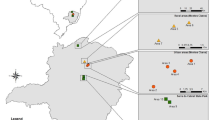Abstract
The little fire ant, Wasmannia auropunctata, is one of the most widely distributed invasive alien ant species on earth, with major environmental, economic and sanitary impacts. Here we report the first established outdoor population of W. auropunctata in South East of France. We describe its detection, its extent and its early ecological impacts. Currently, the invaded area extends over around 1 ha. Given the area invaded and the first reports of stings in 2019, it is likely that W. auropunctata was introduced at least 5 years ago. Although the introduction is probably recent, negative impacts on the abundance and richness of native ants can already be observed. We have not yet recorded any impact on other arthropods. In parallel with identifying the pathway of introduction, an eradication plan is being prepared to tackle this major environmental and economic problem. Widespread species such as the little fire ant represent a new challenge for biosecurity monitoring for Europe.

Similar content being viewed by others
Data availability
The datasets generated during the current study are available from the corresponding author on reasonable request.
References
Angulo E, Hoffmann BD, Ballesteros-Mejia L et al (2022) Economic costs of invasive alien ants worldwide. Biol Invasions. https://doi.org/10.1007/S10530-022-02791-W
Berman M, Andersen AN, Hély C, Gaucherel C (2013) Overview of the distribution, habitat association and impact of exotic ants on native ant communities in New Caledonia. PLoS ONE 23:23. https://doi.org/10.1371/journal.pone.0067245
Bertelsmeier C, Ollier S, Avril A et al (2016) Colony-colony interactions between highly invasive ants. Basic Appl Ecol. https://doi.org/10.1016/j.baae.2015.09.005
Bertelsmeier C, Ollier S, Liebhold AM et al (2017) Recent human history governs global ant invasion dynamics. Nat Ecol Evol 1:0184. https://doi.org/10.1038/s41559-017-0184
Bertelsmeier C, Liebhold AM, Brockerhoff EG et al (2018) Recurrent bridgehead effects accelerate global alien ant spread. Proc Natl Acad Sci USA. https://doi.org/10.1073/pnas.1801990115
Blight O (2019) Risk assessment of Wasmannia auropunctata for the European Union. In : Risk assessment template developed under the “Study on invasive Alien species—development of risk assessments to tackle priority species and enhance prevention”. Contract No 07.0202/2018/788519/ETU/ENV.D.2
Boer P, Vierbergen B (2008) Exotic ants in The Netherlands (Hymenoptera: Formicidae). Entomol Ber 68:121–129
Chifflet L, Guzmán NV, Rey O et al (2018) Southern expansion of the invasive ant Wasmannia auropunctata within its native range and its relation with clonality and human activity. PLoS ONE. https://doi.org/10.1371/journal.pone.0206602
Demetriou J, Georgiadis C, Roy HE et al (2022) One of the World’s worst invasive Alien species Wasmannia auropunctata (Hymenoptera: Formicidae) detected in Cyprus. Sociobiology. https://doi.org/10.13102/sociobiology.v69i4.8536
Demetriou J, Georgiadis C, Martinou AF et al (2023) Running rampant: the alien ants (Hymenoptera, Formicidae) of Cyprus. NeoBiota 88:17–73. https://doi.org/10.3897/neobiota.88.106750
Donisthorpe JK (1927) British ants. Their life-history and classification, 2nd edn. Routhledge & Sons, London, p xv + 436
Espadaler X, Pradera C, Santana JA (2018) The first outdoor-nesting population of Wasmannia auropunctata in continental Europe (Hymenoptera, Formicidae)
Gippet JMW, Bertelsmeier C (2021) Invasiveness is linked to greater commercial success in the global pet trade. Proc Natl Acad Sci. https://doi.org/10.1073/PNAS.2016337118
Gruber MAM, Santoro D, Cooling M et al (2022) A global review of socioeconomic and environmental impacts of ants reveals new insights for risk assessment. Ecol Appl 32:1–17. https://doi.org/10.1002/eap.2577
Jourdan H, Bourguet E, Mille C et al (2022) Impact of invasive little fire ants Wasmannia auropunctata on rainforest soil fauna: implications for conservation of the endangered flightless kagu of New Caledonia. Biol Invasions 24:3675–3680. https://doi.org/10.1007/s10530-022-02882-8
Jourdan H, Sadlier RA, Bauer AM (2001) Little fire ant invasion (Wasmannia auropunctata) as a threat to New Caledonian lizards: evidences from a sclerophyll forest (Hymenoptera: Formicidae)
Le Breton J, Delabie JHC, Chazeau J et al (2004) Experimental evidence of large-scale unicoloniality in the tramp ant Wasmannia auropunctata (Roger). J Insect Behav 17:263–271. https://doi.org/10.1023/B:JOIR.0000028575.28700.71
Longino JT, Fernández F (2007) Taxonomic review of the genus Wasmannia. Adv Ant Syst (Hymenoptera Formicidae) homage to E O Wilson – 50 years Contrib. https://doi.org/10.1016/j.ijinfomgt.2010.01.004
Orivel J, Grangier J, Foucaud J et al (2009) Ecologically heterogeneous populations of the invasive ant Wasmannia auropunctata within its native and introduced ranges. Ecol Entomol. https://doi.org/10.1111/j.1365-2311.2009.01096.x
Rosselli D, Wetterer JK (2017) Stings of the ant Wasmannia auropunctata (Hymenoptera: Formicidae) as cause of punctate corneal lesions in humans and other animals. J Med Entomol. https://doi.org/10.1093/jme/tjx167
Shik JZ, Silverman J (2013) Towards a nutritional ecology of invasive establishment: aphid mutualists provide better fuel for incipient Argentine ant colonies than insect prey. Biol Invasions 15:829–836. https://doi.org/10.1007/s10530-012-0330-x
Vonshak M, Dayan T, Ionescu-Hirsh A et al (2010) The little fire ant Wasmannia auropunctata: a new invasive species in the Middle East and its impact on the local arthropod fauna. Biol Invasions 12:1825–1837. https://doi.org/10.1007/s10530-009-9593-2
Wetterer JK (2013) Worldwide spread of the little fire ant, Wasmannia auropunctata (Hymenoptera: Formicidae). Terr Arthropod Rev 6:173–184. https://doi.org/10.1163/18749836-06001068
Acknowledgements
We thank the inhabitants of the invaded area for their cooperation and for providing access to the site and Marjorie Sweetko for English editing.
Funding
The authors have not disclosed any funding.
Author information
Authors and Affiliations
Contributions
OB designed the study. TT detected the species, CG identified the first specimen and LC raised the alarm by contacting specialists. OB, HJ and J-YB contributed to data collection. OB performed data analysis and wrote the first draft of the manuscript. All authors revised and approved the final manuscript.
Corresponding author
Ethics declarations
Conflict of interest
The authors have no relevant financial or non-financial interests to disclose.
Additional information
Publisher's Note
Springer Nature remains neutral with regard to jurisdictional claims in published maps and institutional affiliations.
Rights and permissions
Springer Nature or its licensor (e.g. a society or other partner) holds exclusive rights to this article under a publishing agreement with the author(s) or other rightsholder(s); author self-archiving of the accepted manuscript version of this article is solely governed by the terms of such publishing agreement and applicable law.
About this article
Cite this article
Blight, O., Thomas, T., Jourdan, H. et al. Detection and early impacts of France’s first established population of the little fire ant, Wasmannia auropunctata. Biol Invasions 26, 627–631 (2024). https://doi.org/10.1007/s10530-023-03218-w
Received:
Accepted:
Published:
Issue Date:
DOI: https://doi.org/10.1007/s10530-023-03218-w




